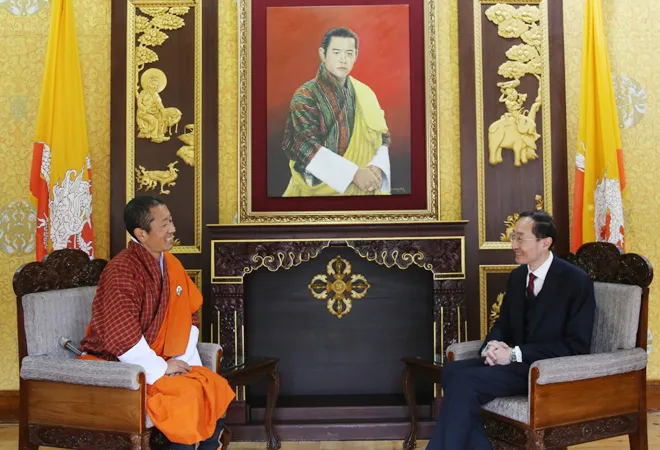
The Chinese Ambassador to India was on a three-day visit to Bhutan from 10 to 13
October, where he met King Jigme Khesar Namgyel Wangchuck, Prime Minister Lotay Tshering, and Foreign Minister, Tandi Dorji. This visit comes one year after Bhutan and China signed a Memorandum of Understanding (MoU) for a 3-step roadmap to expedite boundary talks. The subtle yet significant development indicates that there is an urgency to settle Bhutan’s border disputes amongst all the players—Bhutan, China, and India. Yet the divergent interests of these three stakeholders will continue to pose a significant challenge to any such solution.
Border dispute: An overview
Landlocked between India and China, Bhutan has maintained a special relationship with India since the treaty of Friendship and Cooperation
in 1949. With China, Bhutan has maintained a
neutral relationship, albeit without any diplomatic relations. China
claims certain territories from Bhutan; in the north, Pasamlung and Jakarlung valleys, both of which are culturally vital for Bhutan; and in the west, Doklam, Dramana, and Shakhatoe, Yak Chu and Charithang Chu, and Sinchulungpa and Langmarpo valleys—these lands are pasture-rich and strategically located in the Bhutan-India-China trijunction, lying precariously close to India’s Siliguri Corridor.
In 2020, China made new claims on Bhutan’s East in the Sakteng sanctuary.
The subtle yet significant development indicates that there is an urgency to settle Bhutan’s border disputes amongst all the players—Bhutan, China, and India.
Bhutan began its first border negotiations with China
in 1984. In 1988, both parties drew on fundamental principles to guide negotiations, and in 1998, they signed an agreement to continue negotiations and maintain the status quo. To date, both countries have held 10 expert group meetings and 24 rounds of border negotiations. Considering its geographical size and strategic stakes, Bhutan has been very defensive.
In 2021, Bhutan and China signed an MoU to expedite negotiations and solve the border disputes.
The carrots and sticks approach
The Chinese Ambassador’s recent visit to Bhutan
focused on maintaining friendly exchanges, improving relations, expanding win-win cooperation, promoting China-Bhutan border talks, and moving ahead with the three-step roadmap. This enthusiasm from China indicates Beijing’s increasing keenness to further border negotiations and its strategic and status interests in the region.
China has often used
carrots and sticks to seek a settlement with Bhutan. China has attempted to woo Bhutan, especially with offers of assistance and people-to-people contacts. In
April 2022, China also helped Bhutan by providing medical supplies to fight COVID-19.
However, the use of sticks has intensified in recent years. Starting from the late ’90s, China has encouraged its citizens to
settle in the disputed areas and grazing lands. In the following decades, Beijing has built roads, infrastructure, and even permanent settlements w
ithin Bhutanese territories. Between
2020-2021, satellite images indicated the construction of new villages in the North and the West. These villages are
reinforced with military or police outposts, settlements, well-connected roads and bridges. The increasing intimidation indicates China’s urgency to compel Bhutan to end the border disputes and to also gain a strategic advantage against India.
The Chinese Ambassador’s recent visit to Bhutan focused on maintaining friendly exchanges, improving relations, expanding win-win cooperation, promoting China-Bhutan border talks, and moving ahead with the three-step roadmap.
This urgency is derived from multiple factors: Bhutan’s special relationship with India and the former’s unresolved borders and the absence of diplomatic relations with China continue to haunt Beijing’s aspirations of being an Asian power. Rivalry with India has also consistently motivated Beijing to pressurie Bhutan and attempt to control the disputed regions of Bhutan’s West. The Western region significantly empowers Beijing’s offensive positioning against India vis-à-vis the Siliguri Corridor.
In 1990, Beijing even proposed to trade off Bhutan’s Northern disputed regions in return for the Western disputed regions. Finally, Beijing’s increasing tensions with the United States and India have created angst about tentative challenges from a non-friendly Bhutan, including that of assistance to potential unrest in Tibet.
A common plan for a common threat
On the other hand, recent developments also indicate an increasing urgency and understanding between India and Bhutan on how to deal with China’s expansionism. First, both countries are piggybacking on sector-wise negotiations. While Bhutan has maintained this stance since the 1990s, India has openly shown interest in this tactic since 2020. As tensions with China peaked at Galwan, India
reportedly asked Bhutan to solve its territorial disputes with China so that all the stakeholders could focus on the complex trilateral junctions. In July, the Bhutanese Foreign Minister clarified by
asserting that the 2021 MoU only focuses on solving bilateral issues with China and wouldn’t impact the trijunction areas of the Western borders.
Second, there seems to be mutual interest in using the 2012 agreement to limit China’s expansionism. During the 2017 Doklam standoff, India had strongly condemned China for not abiding by
the 2012 agreement, which stated the trilateral junctions would include negotiations with all the respective parties. However, Bhutan had made no such statement during the standoff, despite
criticising China for constructing roads within Bhutanese territories. But the recent affirmation of solving the dispute
trilaterally also suggests that Bhutan is showing more interest in the agreement and is respecting Indian concerns and toeing with its stance.
The challenges ahead:
Despite this urgency and understanding, there are several challenges:
The first challenge is to see if China would be keen on discussing the trijunction areas with India—which means that Beijing has to shun its decades-old policy of treating the Bhutan-China border dispute as a bilateral issue. This reapproach is even less likely considering the strategic advantage of the Western disputed region and India’s intensifying rivalry with Beijing.
The Bhutanese Foreign Minister clarified by asserting that the 2021 MoU only focuses on solving bilateral issues with China and wouldn’t impact the trijunction areas of the Western borders.
The second challenge is for Bhutan to mitigate India’s angst over increasing Chinese expansion in the Western disputed regions. India has
briefed and sensitised Bhutan of China’s increasing inroads on multiple occasions.
In July 2022, when satellite images of Chinese constructions in Bhutan appeared, the Indian Ministry of External Affairs asserted that it was keeping a close eye on these security-related developments.
That month, India’s Chief of Army Staff discussed areas of further defence cooperation with the Bhutanese king, who is the de-facto supremo of the country’s defence and security issues, along with other key leaders, including the Chief of Army of Bhutan.
In September 2022, the Bhutanese king also met with the Indian Prime Minister and Foreign Secretary to further the bilateral relationship. This increasing cooperation and anxiety also stem from the fact that Bhutan lacks the material capability and presence to avert these continuing intrusions and yet stays reluctant to seek more Indian assistance, fearing more Chinese assertiveness.
The third challenge is that China’s solution to border disputes has often been inclusive of establishing diplomatic relations with Bhutan. Such demands from Beijing will only intensify as its tensions with the US and India increase. These developments will caution India and the US and will also increase the stakes for Bhutan.
Bhutan has been keen on improving relations with China, but deep engagement or establishing diplomatic relations has largely been dictated by other factors. Primarily, Bhutan’s relations with both neighbours are dictated by the ‘
Balance of Threat’ phenomenon. It shunned its isolationist policy and deepened relations with India as China’s
intimidation increased. As a result, Bhutan continues to be integrated with India’s economy, security guarantee, and development assistance. On the other hand, China’s violation of previous agreements, consistent intimidation, and the new territorial claims has done little to counter this threat perception.
Bhutan has been keen on improving relations with China, but deep engagement or establishing diplomatic relations has largely been dictated by other factors.
Bhutan’s growth model of Gross National Happiness will also prevent any deeper economic engagement with China since Beijing’s assistance is often economically and environmentally unsustainable. This is likely to be the case unless the threat perception from Beijing is mitigated. Although the recent visit of the Chinese ambassador indicated some signs of
perception management, a lot would be determined by China’s actions. However, as Xi Jinping starts his
third tenure and focuses on strengthening the Tibetan borderlands, the threat perception is likely to prevail. Finally, to establish diplomatic relations with China, Bhutan will also have to shun its policy of not establishing
diplomatic relations with any of the P-5 countries and staying away from their great power politics.
Resolution to its border disputes will be an arduous task for Bhutan. There is an indication that all the parties have shown interest and urgency in ending this dispute. Yet, the momentum ahead will depend on how their interests and stakes are accommodated; until then, a potential border settlement seems far too distant.
The views expressed above belong to the author(s). ORF research and analyses now available on Telegram! Click here to access our curated content — blogs, longforms and interviews.



 The Chinese Ambassador to India was on a three-day visit to Bhutan from 10 to 13
The Chinese Ambassador to India was on a three-day visit to Bhutan from 10 to 13  PREV
PREV


